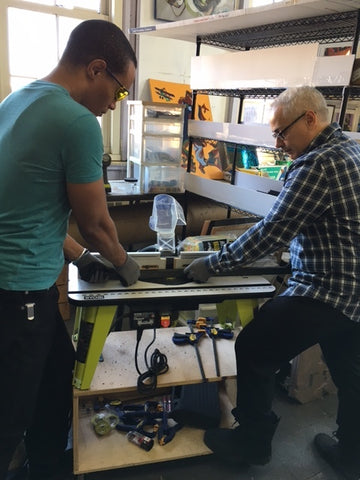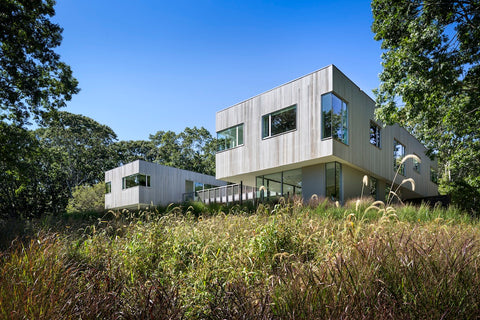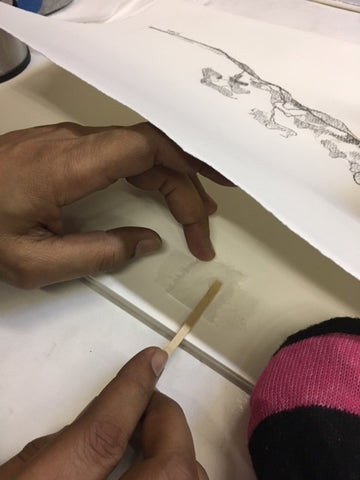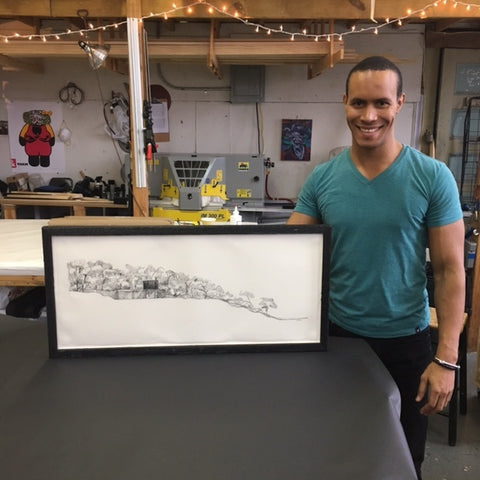January 26, 2017
About two weeks ago, architecture studio Leroy Street Studio (LSS) dropped by Frames and Stretchers with a unique project. They brought in wood treated using Japanese preservation technique Shou Sugi Ban and wanted to know if we could make a frame from it. To be frank, we had never built a frame with these materials before, but decided to take the challenge and it turned out great!

The wood that was treated with Shou Sugi Ban by Leroy Street Studio.
Shou Sugi Ban is an environmentally friendly, ancient Japanese wood preservation technique. It is a multi-step, time consuming process. However, it protects the wood against rot, insects, fire, and can last up to 80 years. The first step is to char the top 1/8" of the boards, then wash them off with water, let them dry, brush off the charcoal dust then leave natural or oil with a sealant. Traditionally Shou Sugi Ban was performed on Japanese cedar wood, but now architects and designers use several different types.

Erick and Antonio work with one of the wood pieces treated with Shou Sugi Ban.
LSS is an award winning architecture studio located on the Lower East Side. They have worked on several stunning residential and public projects, so when they wanted to frame a few sketches for a client with Shou Sugi Ban treated wood we were happy to work with them. LSS does more than just architecture, they also have an in-house construction management and interior design division as well. Besides those divisions, they also started Hester Street Collective; an organization that "engages NYC residents in a transparent, participatory process that ensures the design of neighborhood public spaces reflects local wishes and needs." Ultimately, LSS is pretty awesome all around and we're glad to be their neighbors.

Hill House, one of LSS's completed projects.
First we measured and cut the wood into the proper length. We ran into a small challenge here; we had to figure out how to cut a notch for the glass to rest in. When you build a frame completely from scratch, it does not come with a space for the glass cut. Through a series of tests, we decided to go with the table router machine to create the rabbet for the glass. Next we floated the artwork using Japanese paper and wheat paste then proceeded to joining. After joining the pieces, we completed the frame with museum glass and the best hanging system on the market: the Beehive Picture Hangers.

Floating the artwork with Japanese paper and wheat paste.

Antonio with the completed frame.
In conclusion, Leroy Street Studio was blown away with the result, and we always love a challenge. For more on our day to day happenings, make sure to follow us on Instagram and if you need a project framed stop by our workshop for a quote.
October 07, 2025
Discover Atomic Metal Picture Frames in Miami at Frames and Stretchers Wynwood.
Located near Wynwood Walls, we create custom welded metal frames with industrial style and museum-quality craftsmanship. Choose from finishes like copper with rivets or rust effects, and design a frame that perfectly complements your art and space.
September 12, 2025
we specialize in designing and fabricating custom frames that merge craftsmanship and creativity. For the El Monte exhibition at Pérez Art Museum Miami (PAMM), our Wynwood team created custom arch frames, circular frames, and wood panels with appliqués, all built to museum-quality standards.
Each custom frame is handcrafted in our Wynwood workshop, where precision and design come together to meet the needs of artists, galleries, and collectors across Miami. From arched and round frames to fully custom welded and wood designs, we offer framing solutions that highlight each artwork’s individuality while ensuring lasting protection.
August 29, 2025
At Frames and Stretchers Miami, we specialize in designing and fabricating custom frames that merge craftsmanship and creativity. For the El Monte exhibition at Pérez Art Museum Miami (PAMM), our Wynwood team created custom arch frames, circular frames, and wood panels with appliqués, all built to museum-quality standards.
Each custom frame is handcrafted in our Wynwood workshop, where precision and design come together to meet the needs of artists, galleries, and collectors across Miami. From arched and round frames to fully custom welded and wood designs, we offer framing solutions that highlight each artwork’s individuality while ensuring lasting protection.
